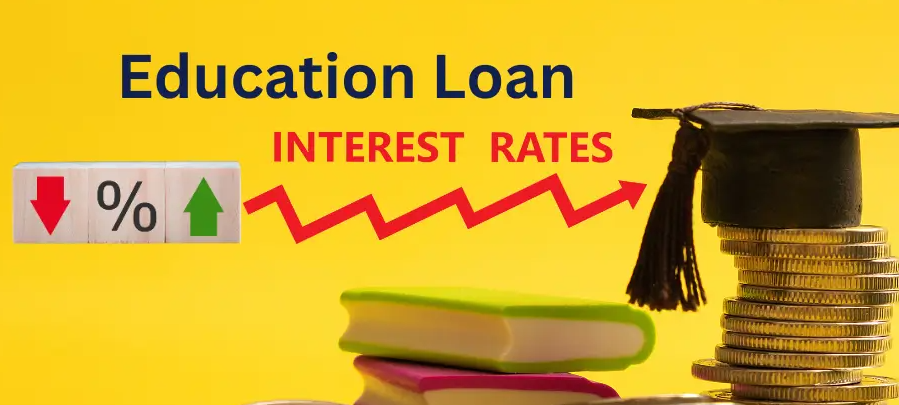
Education Loan provides financial support for students and working professionals who may face financial limitations in covering college expenses, including tuition fees. Banks in India offer easy loans for your education so that you can confidently pursue higher education without breaking the bank. However, with high loan amounts, the bank also levies a certain Education Loan interest rate which directly impacts your monthly EMIs afterwards. Read this post where we will learn about the various factors that banks take into account for Education Loan interest rates.
Understanding Education Loan Interest Rates
When you apply for an Education Loan, the bank gives you the loan amount at a certain rate of interest. This interest rate overall determines the EMI that you will be repaying during the loan lifecycle. Furthermore, you can use the money to pay for college expenses like fees, study material, hostel fees, etc. and protect your savings.
The banks decide the rate of interest for the loan which is further based on many other factors. In India, Education Loan interest rates are primarily linked to benchmark rates like the Repo Rate, MCLR (Marginal Cost of Funds Based Lending Rate), and RLLR (Repo Linked Lending Rate). Remember, many other factors also influence the final interest rate offered to the applicants.
Key Factors That Affect Education Loan Interest Rates
Banks consider several factors when approving an Education Loan for applicants. These are as follows:
-
Repo Rate and Benchmark Rates
The Repo Rate, set by the Reserve Bank of India (RBI), directly impacts the interest rates on Education Loans. When the repo rate increases, borrowing costs for banks rise, leading to higher loan interest rates for students. Conversely, a lower repo rate results in lower interest rates. Banks also use RLLR, MCLR, and EBLR (External Benchmark Lending Rate) to adjust loan interest rates periodically.
-
Loan Amount and Repayment Tenure
The loan amount and repayment period impact the overall interest cost and EMI. Higher loan amounts may lead to higher interest expenses due to increased risk for lenders. Longer repayment tenures result in lower EMIs but higher total interest paid over time. Conversely, smaller loan amounts with shorter tenures reduce overall interest costs.
-
Credit Score of the Applicant
A high CIBIL score (credit score) helps students secure loans at lower interest rates. A score of 750 or above indicates good creditworthiness and reduces the risk for banks. If the student has a low or no credit score, banks may evaluate the co-applicant’s (parent or guardian) credit score to determine the loan’s interest rate.
-
University and Course Selection
Banks offer preferential interest rates to students admitted to top-ranked universities. Some banks provide interest rate concessions for students enrolling in the most prestigious universities in India and abroad. Courses that lead to high employability, such as engineering, medicine, or management, may also attract lower interest rates.
-
Co-applicant or Co-signer
Having a financially stable co-applicant (parent or guardian) or co-signer can significantly reduce interest rates. Banks consider the co-applicant’s financial profile, income, and credit history to determine the risk factor. A strong financial background reduces the risk and may lead to lower interest rates.
-
Collateral vs. Non-Collateral Loans
Education Loans are categorised as secured (with collateral) and unsecured (without collateral). Secured loans or loans with collateral have lower interest rates due to reduced risk. Unsecured loans or loans without collateral have higher interest rates as banks assume more risk. Providing collateral such as Fixed Deposits, property, or insurance policies can help in securing lower interest rates.
Tips to Secure the Lowest Education Loan Interest Rate
-
Maintain a Good Credit Score
To maintain a good score, ensure timely payments on any existing loans or Credit Cards, avoid defaults, and limit excessive borrowing.
-
Choose a Reputed University and Job-Oriented Course
Many banks offer interest rate concessions to students who secure admission to top 100 or 200 ranked universities worldwide. Similarly, selecting a job-oriented course like medicine, engineering, or management may help in getting favourable interest rate, as these fields have better earning potential post-graduation.
-
Apply with a Financially Strong Co-applicant
A co-applicant is usually a parent or guardian who shares responsibility for repaying the loan. If the co-applicant has a stable income and a good credit history, banks may offer a lower interest rate.
-
Opt for Secured Loans with Collateral
Consider pledging collateral such as Fixed Deposits, property, or Life Insurance policies to secure better loan terms while applying for an Education Loan. These assets provide security to the lender to recover losses in case of default.
-
Compare Interest Rates Across Different Banks
Interest rates vary across different banks, that is why, before finalising a loan, compare interest rates, processing fees, repayment flexibility, and moratorium period options offered by different lenders. You can also use an Education Loan calculator online, which can help in finding the most affordable loan by comparing various loan rates and EMIs.
Conclusion
Education Loan interest rates in India depend on multiple factors, including the repo rate, loan amount, tenure, university selection, credit score, and collateral availability. Understanding these factors can help students and their families make informed decisions while securing an Education Loan. Comparing different lenders and opting for government subsidies can further reduce the financial burden, making higher education more affordable.